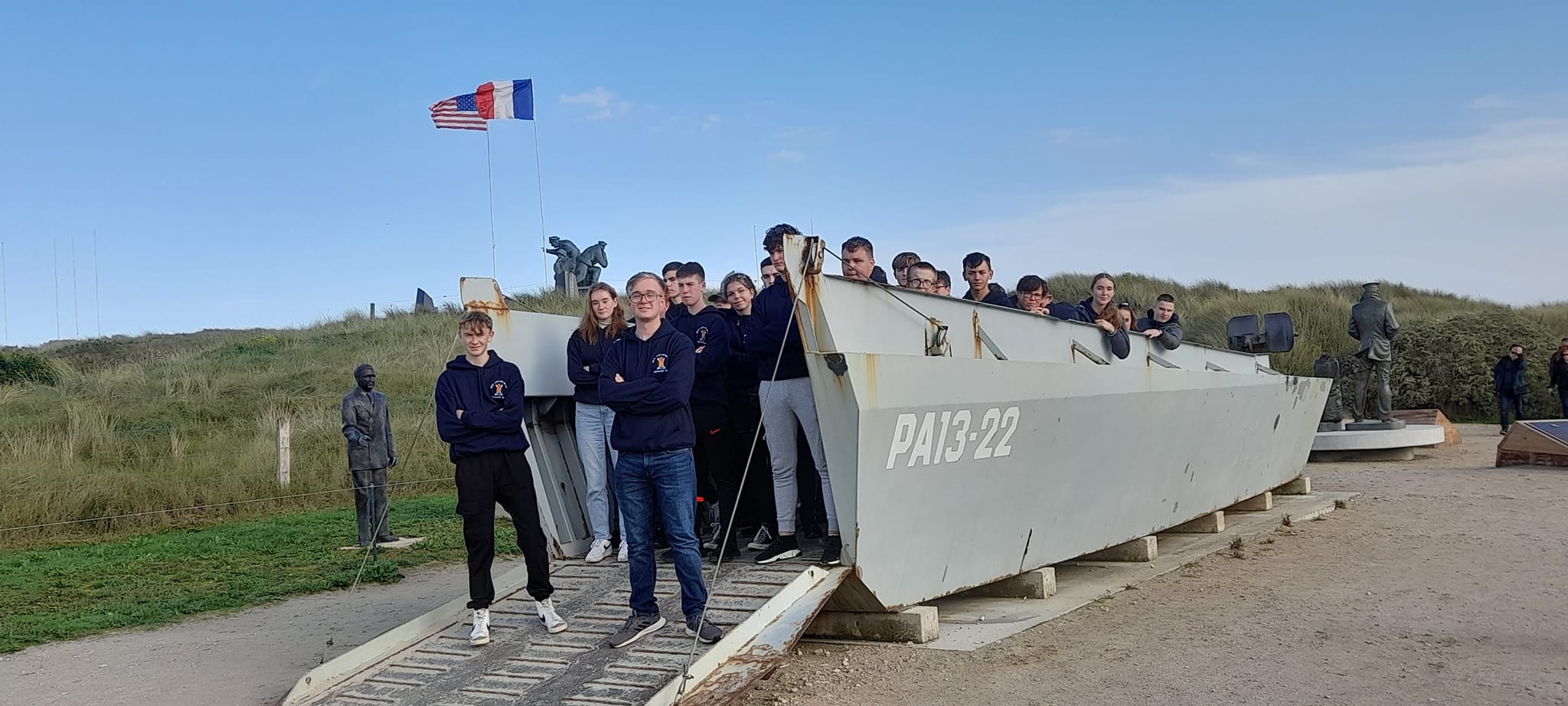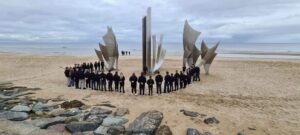
In October 2022, after much waiting, organising and re-organising, Army Cadet Force Cadets and CFAVs from both West Lowland Battalion and Glasgow & Lanarkshire Battalion packed their bags and set off to France on a World War II battlefield tour.
As the buses departed the Cadet Training Centres (CTC), the sense of adventure was palpable among Cadets and adults alike, some of whom have kindly recounted their experience for our enjoyment.
Glasgow & Lanarkshire Battalion
Day One
‘So here we are… three years in the planning and finally we are ready to go!’ said Colonel Derek Coulter, Commandant of Glasgow & Lanarkshire Battalion.
‘The bus arrived bright and early and soon we were off. The bus journey was spent playing bingo, which was a big hit with the Cadets; before we even knew it we were at Hull ready to board the ferry.
‘We all got settled in and then enjoyed a lovely four-course meal before the Cadets had some downtime to explore the boat. Later on in the evening we all regrouped to enjoy the ferry entertainment: a live band followed by a disco. Within about ten minutes the Cadets went from saying “We don’t dance” to doing the YMCA, Cha Cha Slide and the Macarena!’
Day Two
Cadet Company Sergeant Major Scott Connor of the Battalion’s Invictus Company was more than moved by the first stop on the Battlefield Tour:
‘When we arrived at Pegasus Bridge everyone knew what it was despite many of us not knowing much about it; its unique design stands out so much compared to the normal brick bridges.
‘We then went off to the hotel where we were warmly greeted with a delicious three-course meal. Fun fact: the French don’t have cheese on crackers, they eat it on its own or with salad!
‘For me, the most memorable part of the trip was the USA Normandy Cemetery. We always hear about how many people died during the War, but that is just a number until you visit a place like this and see the endless rows of headstones; that number then takes on a much greater significance.’
Day Three
‘On our third day we set off to visit the memorial sites, beaches and the Caen memorial museum, which we spent the most time at,’ said Cadet Pearce O’Brien from 2 Platoon Royal Scots Borderers (RSB) Motherwell Cadets. ‘For as long as I can remember I have been passionately interested in history… so I had been very much looking forward to visiting the museum and seeing what I read so much about. There was a wealth of artefacts ranging from letters, diaries, weapons and even a German Major General’s uniform, and it was uniquely beneficial to see the war from the French perspective. It focused more on the catastrophic defeat of France in mid-1940 and the famed French Resistance than a British museum perhaps would.
‘The most impactful part of the day was our visit to the American and British war memorials, which affected and humbled me greatly. The American memorial was composed of almost 10,000 graves of US servicemen who died in Normandy, with massive and perfect rows of white crosses and stars of David, a very visual reminder of the great sacrifice of American soldiers who fought and died for Freedom in Europe. At the centre was an immaculate chapel with a beautiful mosaic ceiling depicting an American soldier being embraced by Mary after dying on the beaches of Normandy.
‘We then observed the poignant lowering of the Stars and Stripes as the sun started to set, as the American flag may not be left in darkness over the memorial. Our last stop was the British war memorial. It was in the style of the Cenotaph in London: a large concrete set of structures and pillars, containing the names of the soldiers, but not their bodies like the American memorial. It was stoic and subtle in the manner that war memorials all over Great Britain are but larger.
‘I had the immense privilege of laying a wreath at the heart of the memorial, which I will never forget. There were over 24,000 names, and I found two bearing my name, a Lance Corporal and Lieutenant O’Brien who were both barely in their twenties. I am now even more appreciative of the sacrifice of my preceding countrymen and their allies in the war, and will never forget their effort and sacrifice.’
Day Four
Corporal Bradley Kerr, a piper with Amiens Company, 3 Platoon RSB Newmains, shared how a Battlefield Tour filled with educational and often sombre moments still managed to end on a high note.
‘After a day of piping and travelling around the beaches, we spent our final day in France at Disneyland Paris.
‘We got to experience the hair-raising rollercoasters and the amazing characters, and the fabulous Disney on Parade show. At night, we witnessed the beautiful lights and firework show. It was a magical experience with all of my friends in the ACF and I would do it again in a heartbeat.
‘The Normandy trip was one of the most interesting camps I have been on in my Cadet career, as I love WW2 history… I loved playing the pipes for the trip and I loved the history. This trip boosted my confidence and independence through having to navigate a foreign country, and helped me become closer to my friends and CFAVs. Disneyland wasn’t half bad either!’
Captain Raymond Bell, the Officer in Charge (OIC) of the tour also shared a few final thoughts on the overall success of the trip: ‘As the OIC I was very impressed with the level of detail the Cadets already knew about the Normandy landings, as well as being willing to teach others.
‘The Cadets have been a credit not just to the Battalion but their teachers at school and families. Now we are home I am already looking at planning my next battlefield tour to Berlin.’
West Lowland Battalion
Day One
‘The first challenge of the trip was the Rotterdam to Normandy coach journey,’ explained Colonel Alan Middleton, West Lowland Battalion Commandant. ‘In order to allow the required rest period for the driver’s hours, our tour guide suggested that we stop at the Somme and visit the Thiepval Memorial which was an added insight and broke up the long journey perfectly.
‘On our return journey the same rest period coincided with a stop-off at the Vimy Ridge Canadian Memorial… Although both of these were WWI sites they were of great interest and gave the Cadets and Adults an idea of the sacrifice and commitment of those battles.’
Day Two
On Day Two the Battalion visited Pegasus Bridge where Staff Sergeant Instructor (SSI) Frank Kennedy, a former Regular Airborne soldier, helped guide John Carey bring events to life. On 6 June 1944, glider-borne troops of the 6th Airborne Division captured the Benouville Bridge. As an ex paratrooper, it was an emotional moment for Frank to visit the bridge and museum.
He spoke to the Cadets at the site of where the three gliders landed. They were all awestruck by the skill and bravery of the glider pilots. It was one of the most outstanding flying achievements of WWII.
Day Three
Day Three was the day West Lowland Bn visited Utah Beach. This was the codename for D-Day’s westernmost landing point. At 0630 on 6 June 1944 the U.S. 4th Infantry Division came ashore, mainly in landing craft, with the task of establishing a bridgehead at the base of the Cotentin peninsula. This was an important assignment in the effort to seize the deep-water port of Cherbourg as quickly as possible.
The Cadets walked in the footsteps of past heroes: from the sea, up the beaches and through the dunes where 197 soldiers were lost during the landing with 60 missing. The Cadets also had the opportunity to feel what it was like to stand in the landing craft and disembark as a squad.
Later, while visiting Sword Beach, the Cadets were told the story of Piper Billy Millin who was a member of the Lovat Scouts – a British unit that landed on Sword Beach at 0725 on D-Day.
Piper Milliin played his pipes moving up and down the beach as troops and tanks stormed ashore. There are reports that German defenders did not fire at him as they thought he had gone mad with ‘shell-shock’. West Lowland’s own Pipe Major Sandie Greenwood played at Piper Millin’s memorial, bringing the place and the locals to a standstill.
Regimental Sergeant Major Instructor (RSMI) Wakelam spoke to the Cadets about the connection he has with the area as his father was in the Royal Navy and was a Coxswain (Driver) of a Landing Craft Tank (LCT) at Sword Beach on D-Day at the age of just 21. Under heavy fire, he landed Tanks of The 13th/18th Hussars and men of No. 4 and 6 Commando, before then taking part in the following campaign for Normandy, landing more troops, tanks & equipment over several weeks. RSMI Wakelam also had the honour of laying a wreath to his father at the British War Memorial while Pipe Major Greenwood played a moving lament.












